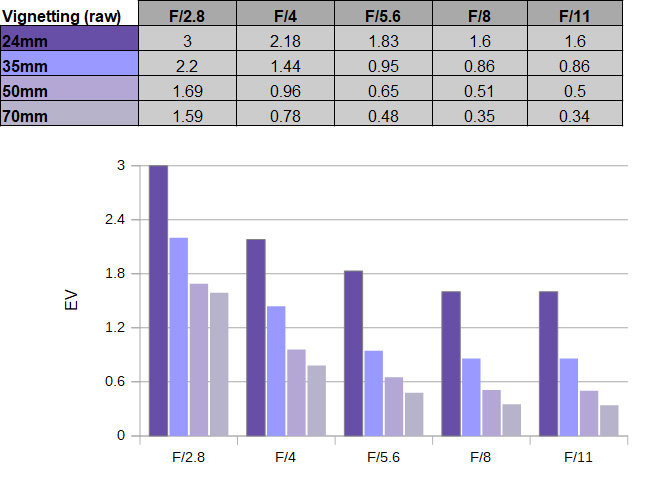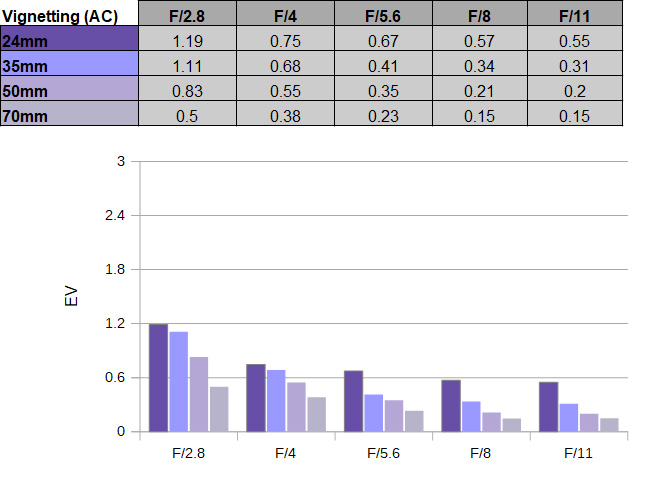|
Canon RF 24-70mm f/2.8 USM L IS - Review / Test Report - Analysis |
|
Lens Reviews -
Canon EOS (Full Format)
|
|
Page 2 of 3

Distortion
The Canon RF 24-70mm f/2.8 USM L IS produces a complex barrel distortion (mustache-style) at 24mm. It's not extreme in terms of the numerical figure but you will be able to spot it. Images are pretty much distortion-free around the 35mm setting. Slight pincushion distortion takes over towards the long end of the range.
Of course, this is all mostly irrelevant (other than a slight decrease in corner resolution) with activated image auto-correction as you can see below.
Vignetting
The vignetting characteristic comes as a bit of a surprise. The lens has a very large front element yet the vignetting is very high at 24mm f/2.8. Stopping down helps but not quite as much as you may have hoped. The light falloff remains very visible at f/8 at this setting. The issue isn't quite as pronounced at longer focal lengths but still very noticeable at maximum aperture.
 Once again, if you prefer to activate image auto-correction, the algorithm reduces the fall-off substantially although you can still spot a bit in the lower zoom range at large apertures.
Once again, if you prefer to activate image auto-correction, the algorithm reduces the fall-off substantially although you can still spot a bit in the lower zoom range at large apertures.

MTF (resolution)
The Canon RF 24-70mm f/2.8 USM L IS is a very sharp lens overall but it also has its weaknesses. At 24mm the broader center zone is tack sharp straight from f/2.8. The borders are also very good. However, the corner quality could be better at maximum aperture. Stopping down to f/4 boosts the corners and they are very sharp indeed at f/5.6. The center and border characteristics remain intact at 35mm but the corner quality decreases somewhat overall. The sweet spot of the lens is around the 50mm mark where it exhibits no real weakness. As so often, the quality decreases at the long end of the range. Once again the broader center is great but the border quality decreases to good levels and the corners are a bit soft. Stopping down to f/5.6 solves most of this once again.
The field curvature is generally low. The centering quality of the tested sample was Ok.
Please note that the MTF results are not directly comparable across the different systems!
Below is a simplified summary of the formal findings. The chart shows line widths per picture height (LW/PH) which can be taken as a measure of sharpness.
If you want to know more about the MTF50 figures, you may check out the corresponding Imatest Explanations

Chromatic Aberrations (CAs)
Lateral CAs (colors shadows in the outer image field) are generally quite low but if you are into pixel peeping, they are visible at 24mm at least - unless you activate image auto-correction.

Bokeh
A 24-70mm f/2.8 lens isn't TERRIBLY fast but the large aperture and its shallow depth-of-field capabilities are, of course, one of the primary reasons for investing in such a lens. So rather than having a look at the sharpness, let's switch to the discussion of the unsharpness (out-of-focus rendition) now.
Out-of-focus highlights show an onion-like substructure - probably related to the 3 aspherical elements in the design. Obviously, this is less than ideal. However, the highlights remain circular from f/2.8 to f/5.6 - thanks to the 9 rounded aperture blades.
 The shape of the highlights tends to deteriorate towards the image borders - due to mechanical vignetting. However, the Canon behaves better than most in this respect in that the shape deteriorates "late". As you can observe below, only the corner highlights are "cut". Stopping down improves those highlights and they are pretty good at f/5.6.
The general rendition in the focus transition zones is very smooth both in the background (to the left below) as well as the foreground (to the right).
The shape of the highlights tends to deteriorate towards the image borders - due to mechanical vignetting. However, the Canon behaves better than most in this respect in that the shape deteriorates "late". As you can observe below, only the corner highlights are "cut". Stopping down improves those highlights and they are pretty good at f/5.6.
The general rendition in the focus transition zones is very smooth both in the background (to the left below) as well as the foreground (to the right).

Bokeh Fringing (LoCA)
Bokeh fringing - also referred to as LoCAs - is a color fringing effect on the Z-axis. It shows up as purplish halos in front of the in-focus zone and greenish beyond. The effect is clearly visible at f/2.8. Stopping down to f/4 reduces the fringing and there are traces left at f/5.6. Keep in mind that bokeh fringing is normal in all but a handful of very expensive APO lenses.
|